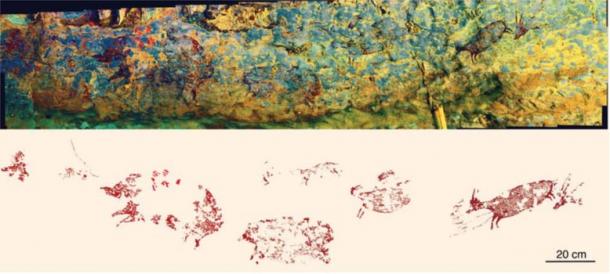🔴 Website 👉 https://u-s-news.com/
Telegram 👉 https://t.me/usnewscom_channel
A groundbreaking discovery in Sulawesi, Indonesia, has unveiled the oldest known narrative cave art, dating back at least 51,200 years. This revelation, published in the journal Nature, not only rewrites the timeline of human artistic expression but also showcases the advanced storytelling abilities of our ancient ancestors.
Unveiling the Ancient Artwork
In the Maros-Pangkep region of Sulawesi, researchers have identified a cave painting featuring human-like figures interacting with a wild pig. The depiction of these scenes suggests a level of sophistication in early human culture previously unrecognized.
“Our discovery suggests that storytelling was a much older part of human history… than previously thought,” study co-author archaeologist Adam Brumm told a press conference, reported Phys.org.
Using a novel dating method, scientists have provided a more accurate age for this artwork, pushing back previous estimates by at least 5,700 years. This finding suggests that early humans were creating complex narrative scenes much earlier than previously thought.
The Challenge of Dating Prehistoric Art
Dating prehistoric rock art accurately has long been a challenge for archaeologists. Traditional methods, like the solution-based uranium-series technique, involve analyzing calcium carbonate deposits that naturally form on top of cave paintings. By measuring the radioactive decay of uranium into thorium within these deposits, researchers can estimate the minimum age of the underlying art. However, the complexities of rock growth histories often result in underestimation of the art’s true age.
To overcome these limitations, Adhi Agus Oktaviana, Maxime Aubert, and their colleagues employed a cutting-edge approach known as laser ablation uranium-series imaging (LA-U-series). This method uses a laser coupled with a mass spectrometer to analyze calcium carbonate samples in exquisite detail. By focusing on materials closer to the pigment layer, this technique yields more accurate age calculations.
Revolutionary Dating Method
Applying the LA-U-series method, researchers analyzed a hunting scene at Leang Bulu’ Sipong 4, previously dated to at least 43,900 years ago. The new analysis suggested the painting is at least 48,000 years old, making it one of the oldest narrative paintings in the world.
Hunting scene at Leang Bulu’ Sipong 4: the top image shows a photostitched panorama of the rock art panel; the bottom image is a digital tracing of the rock art scene. (Ratno Sardi / Adhi Agus Oktaviana/Nature)
The researchers then turned their attention to a previously undated painting at Leang Karampuang, depicting three human-like figures interacting with a pig. Using the advanced dating method, they determined this artwork to be at least 51,200 years old. This makes it the earliest known figurative cave art and the oldest narrative scene discovered to date.
Aerial Photo Karampuang Hill, where the oldest narrative art has been found. (Google Arts & Culture/Nature)
Implications for Human History
The discovery of such ancient narrative art challenges existing assumptions about the evolution of human artistic expression. Previously, it was believed that the portrayal of human-like figures and the use of narrative scenes in art became common towards the end of the Late Pleistocene, around 14,000 to 11,000 years ago. However, the Sulawesi findings indicate that these complex forms of artistic expression emerged much earlier.
The implications of this discovery extend beyond just the age of the artwork. It suggests that early humans possessed advanced cognitive abilities, enabling them to create and comprehend complex narratives. This capacity for storytelling and symbolic representation is a fundamental aspect of what makes us human.
Advancing Archaeological Methods
The success of the LA-U-series method in providing accurate dates for the Sulawesi cave paintings shows the potential for this technique to revolutionize the field of archaeology. Compared to the traditional solution-based method, the LA-U-series approach is faster, more cost-effective, less destructive, and provides better spatial resolution. This improved accuracy is crucial for developing a clearer understanding of early human culture and its development over time.
The findings from Sulawesi not only enhance our knowledge of prehistoric art but also pave the way for future discoveries. As researchers continue to apply advanced dating techniques to other ancient artworks, we can expect further revelations about the origins and evolution of human creativity.
The study ‘Narrative cave art in Indonesia by 51,200 years ago’ has been published in Nature.
Top image: Dated Rock Art Panel at Leang Karampuang Source: Provided by Griffith University /Nature
By Gary Manners
